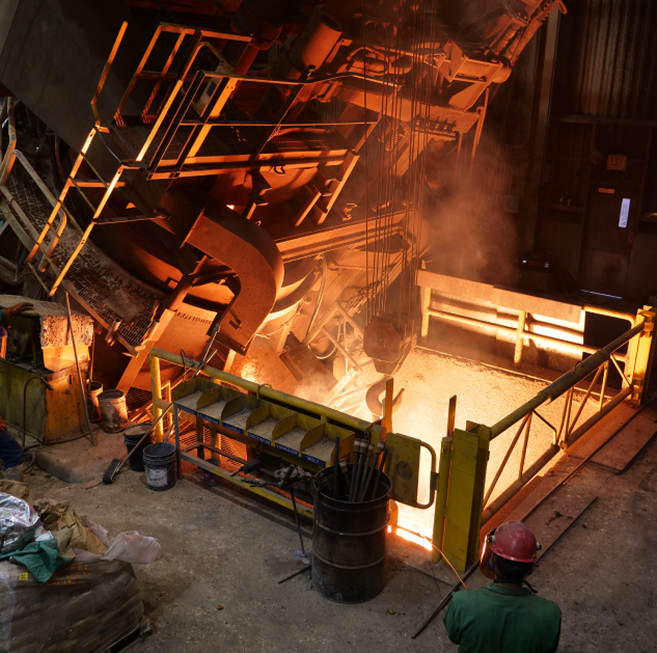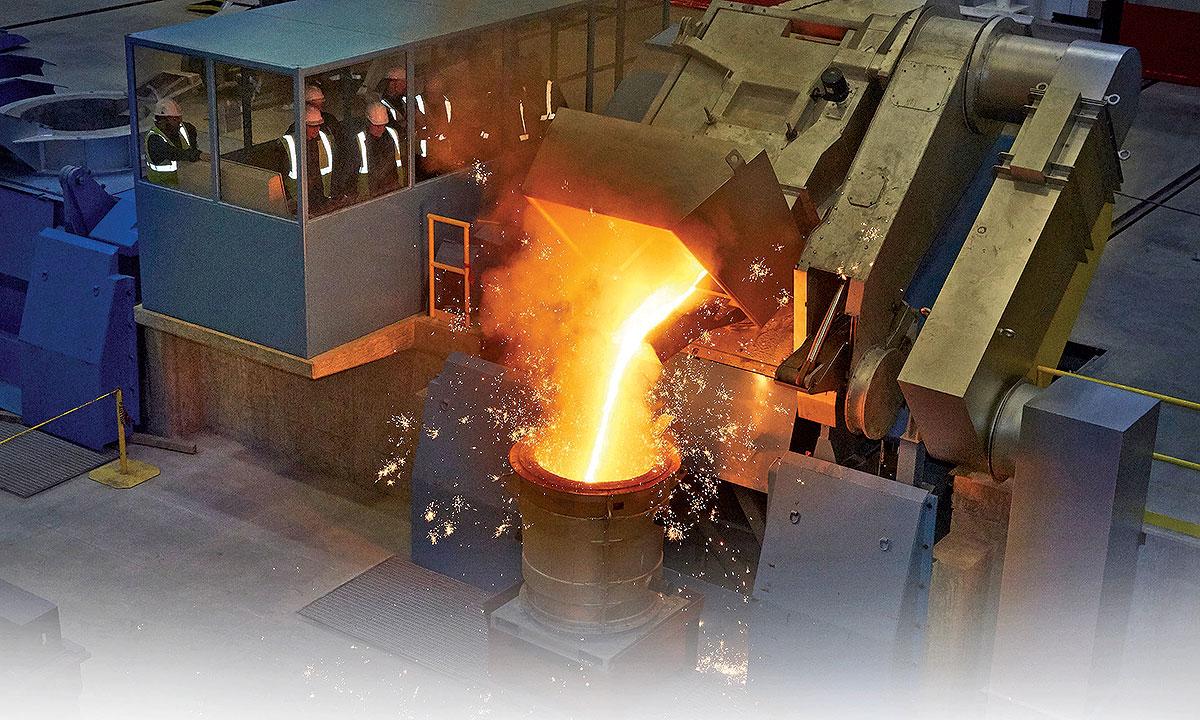Discover the Ingenious Methods Used in a Metal Foundry for Superior Casting Results
In today's affordable production landscape, metal foundries are significantly adopting cutting-edge strategies to enhance spreading outcomes - Metal Foundry. Advanced computer system simulations enable specific modeling of molten metal habits, while 3D printing allows fast production of intricate mold and mildews. In addition, environment-friendly materials and automation streamline operations. These developments guarantee considerable renovations in efficiency and high quality control. Nevertheless, the effect of these modern technologies on sustainability and manufacturing techniques remains to be completely checked out
Advanced Computer System Simulations in Metal Casting
Advanced computer simulations have actually revolutionized the metal casting process by boosting precision and effectiveness. These sophisticated tools permit engineers to produce digital models of cast elements, enabling them to analyze and anticipate the behavior of liquified metal throughout the spreading stage. By simulating different criteria such as temperature level, flow price, and air conditioning rates, suppliers can determine possible defects prior to physical production starts.
This aggressive approach lowers waste and lessens expensive mistakes, ultimately resulting in improved product high quality. Additionally, simulations help with the optimization of mold and mildew layouts, making certain that they fulfill the specific requirements of each task. The combination of computational liquid dynamics (CFD) and finite component analysis (FEA) additional adds to the precision of these simulations, providing insights that were formerly unattainable. Therefore, advanced computer system simulations have actually come to be a crucial part of modern metal foundries, considerably progressing the sector's abilities.
3D Printing for Mold And Mildews and Patterns
3D printing has actually emerged as a groundbreaking strategy for producing mold and mildews and patterns in the metal foundry market. This innovation makes it possible for the fast production of complicated geometries that typical manufacturing approaches struggle to accomplish. By utilizing additive production, foundries can develop detailed designs with minimized preparations and material waste. The capability to create mold and mildews on demand permits better versatility in design versions, promoting faster prototyping and adjustments.
In addition, 3D printing can make use of a range of products, including metals and plastics, tailored to particular casting requirements. This flexibility enhances the precision of molds, causing exceptional spreading end results with boosted surface area finishes. In addition, the reduction in the variety of components needed streamlines setting up procedures, additionally maximizing manufacturing performance. As foundries proceed to take on 3D printing, they are poised to redefine market standards, leading the way for development and boosted efficiency in metal casting operations.
Eco-Friendly Materials and Processes
As the metal foundry market encounters enhancing stress to lower its environmental footprint, the adoption of eco-friendly products and procedures has become vital. Factories are now checking out lasting choices to conventional materials, such as utilizing recycled metals and bio-based binders. These materials not only minimize waste yet also lower energy usage during manufacturing.
In addition, innovations in sand spreading methods have resulted in making use of artificial sands that are less hazardous to the environment. Shops are also applying cutting-edge processes like liquified metal treatment that lowers exhausts and enhances the top quality of actors items.
Additionally, water-based coatings have actually changed poisonous solvents, advertising a safer work setting (Aluminum Casting). By integrating these green methods, metal foundries can considerably decrease their eco-friendly effect while keeping high-grade spreading outcomes. This change not just profits the setting however likewise lines up with the expanding customer need for lasting production remedies
Automation and Robotics in Foundry Workflow
While the metal foundry industry embraces innovation, the integration of automation and robotics is transforming procedures significantly. Automated systems streamline processes such as mold production, metal pouring, and casting ending up, greatly improving efficiency. Robotics promote the handling of heavy materials, reducing the threat of work environment injuries and making sure much safer settings.

Even more, using automated led vehicles (AGVs) maximizes material transport within centers, making certain prompt shipment of components to appropriate workstations. By implementing these innovations, foundries can adapt to varying needs with greater dexterity, inevitably resulting in enhanced success and competitiveness in the marketplace. As automation and robotics proceed to develop, they hold the prospective to redefine conventional foundry practices and drive more innovations in casting techniques.
Real-Time Tracking and Quality Assurance Techniques
The innovations in automation and robotics have led the means for extra advanced methods to high quality assurance in metal foundries. Real-time tracking systems utilize sophisticated sensing units and information analytics to track crucial criteria throughout the casting process. These systems constantly assess variables such as temperature level, pressure, and material structure, enabling immediate discovery of variances from established criteria.
Quality assurance techniques currently integrate device understanding formulas that evaluate historical data to anticipate potential issues prior to they take place. This aggressive method minimizes waste and boosts overall production effectiveness. Additionally, incorporated feedback loops permit for fast changes, guaranteeing that each casting fulfills strict top quality needs.
The execution of electronic doubles-- virtual reproductions of physical assets-- has actually also revolutionized quality assurance, allowing designers to replicate and enhance processes in real-time. Together, these ingenious strategies substantially improve the dependability and top quality of spreadings, setting new sector requirements in metal foundry operations.
Regularly Asked Inquiries
What Kinds of Metals Are Typically Cast in Shops?
Frequently cast metals in foundries consist index of light weight aluminum, brass, iron, and bronze. Each metal exhibits distinct homes, making them suitable for numerous applications, such as vehicle components, machinery, and artistic sculptures, boosting their flexibility in manufacturing.

Just how Lengthy Does the Casting Process Generally Take?
The spreading procedure usually takes numerous hours to days, relying on variables such as the intricacy of the mold and mildew, sort of metal utilized, and cooling demands. Each phase influences the general duration noticeably.
What Precaution Are in Location for Foundry Workers?

How Are Problems in Castings Identified and Addressed?
Defects in castings are recognized with aesthetic inspections and non-destructive screening methods. Once found, foundry workers address them by fine-tuning procedures, adjusting material structures, and applying corrective measures to ensure high quality and compliance with requirements.
What Is the Price Array for Metal Casting Providers?
The price variety for metal casting solutions generally differs in between $1 to $10 per extra pound, relying on elements such as material kind, complexity of the layout, and production quantity, affecting overall prices considerably.
In today's competitive manufacturing landscape, metal foundries are significantly taking on innovative techniques to boost spreading outcomes. As the metal foundry industry encounters boosting stress to reduce its ecological footprint, the fostering of environment-friendly materials and procedures has come to be vital. Factories are now checking out sustainable alternatives to typical products, such as using recycled steels and bio-based binders. By incorporating these green methods, metal foundries can substantially lower their ecological impact while preserving premium spreading results. The improvements in automation and robotics have actually paved the way for extra innovative techniques to high official site quality assurance in metal foundries.